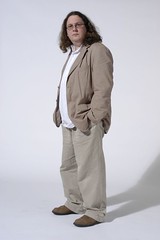Sunday, October 09, 2005
I've been thinking about what will make a successful company in the Computing 5.0 world.
There's a lot of hype about platforms, but I think that things go a lot deeper. To be successful in tomorrow's IT world companies must be able to point to a stack of components that include their software and hardware - along side open standards that help them work in a heterogeneous environment. If you think that you will control everything, then you're unlikely to get anywhere.
Very few companies seem to understand the stack, and how it fits together.
EMC seems to have been one of the first to seize on the stack model, understand where it could add value, and make the appropriate acquisitions and partnerships to move forward. By understanding that intelligent storage and virtualisation were key components of any future service architecture, EMC chose its stack components carefully. Leaving open interfaces at all levels, it's in a process of integrating Documentum and Legato into its storage hardware - making rules-based content and object management part of your infrastructure, not your applications. It doesn't matter what else you add to the stack - EMC has made sure that it's in an excellent position for the next decade.
BEA is another company that understands the stack. Focusing on middleware as the new infrastructure, and providing the tools to integrate with a range of different middleware technologies, as well as orchestrating processes, BEA is facing a challenging couple of years. However, if it sticks to its guns and keeps its focus I suspect that it will become a big winner. Its acquisition of Plumtree makes a lot of sense here, as BEA seems to have realised that its strengths lie in building the next generation of network infrastructure.
Other players that seem to be making a bid for Computing 5.0 include Google, SAS, Microsoft and Yahoo!.
There are companies that have failed to understand how the stack will fit together. Oracle has made the mistake of buying its customer base twice over with recent acquisitions. While its Fusion model appears to offer a "plug and play" middleware approach, there appears to be too much of a SAP-style reliance on fixed business processes and specific ways of working. IBM is missing the synergy between its Websphere applications and its hardware, as well as Lotus' knowledge management tools. Its cosy relationship between its platform business and Global Services is a danger as it could lead to complacency.
Others are focussing on niches that are too small. Apple may well end up dominating the living room, but you can only do so much with iTunes. Adobe may make some headway with its Acrobat LiveCycle, but it needs to work more closely with companies like EMC. Otherwise it'll become purely a developer of UI design tools.
Of course there are plenty of small companies out there who will bring their expertise to the table. The open source world is rapidly becoming stack-based, and companies like MySQL and JBoss seem ready to work with stack support vendors to produce integrated platforms. The blended model that BEA is attempting with Eclipse and Apache looks to be an interesting alternative.


1 Comments:
I was amused by this quote from James Utzschneider at the Microsoft Busienss Summit.
"Oracle is arguing that the vendor with the best “integrated stack” will win, because customers are looking for integrated solutions that deliver value. It’s actually funny, because if you look at Oracle’s own presentation to investors from last week when they announced the Siebel acquisition, they include a slide with a side-by-side comparison of the software stacks from Oracle, IBM, SAP and Microsoft. The slide clearly shows that Microsoft has the best, most complete integration of software from application solution down to operating system. So we think we are on to something."
http://www.microsoft.com/presspass/features/2005/sep05/09-19BusinessSolutions.mspx
Post a Comment
<< Home